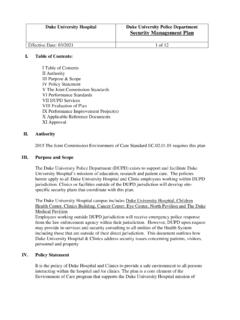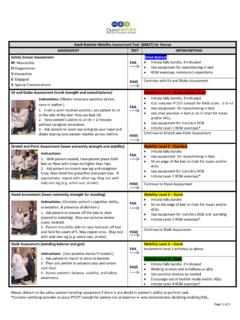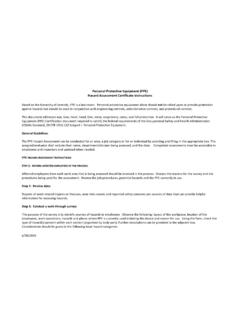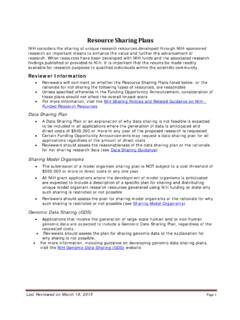Transcription of Medical Equipment Management Plan - Duke University
1 Policy/Procedure: DUHS 2020 Medical Equipment Management plan Document ID:1069 Revision Number: 3 Status: Review Origination Date: 07/31/2007 Effective Date: 1/1/2021 Entity: DHCH DHTS DPC DRAH DRH DUH PDC PHMO SOM Electronic versions of documents will always supersede printed versions. Intellectual Property of Duke Health. All Rights Reserved. Page 1 of 6 Medical Equipment Management plan 2021 I. Introduction, Mission Statement, and Scope The Medical Equipment Management plan defines the mechanisms for interaction and oversight of the Medical Equipment used in the diagnosis, treatment, and monitoring of patients. The related policies and procedures govern activities from selection and acquisition to incoming inspection and maintenance of Medical Equipment . The mission is to ensure that Equipment used in patient care is safe, available, accurate, and affordable.
2 The scope of this plan is Duke University Health System including Duke University Hospital, Duke PDC, Duke DPC, Clinical Laboratories, Duke Regional Hospital and Duke Raleigh Hospital. II. Organization of Participants The administration and oversight of Medical Equipment Management is the responsibility of Clinical Engineering. Management of Medical device incidents is the primary responsibility of Risk Management . III. Medical Equipment Management The primary policies for the Management of Medical Equipment are found at: Duke University Health System o DHTS DHTS Clinical Engineering IV. Medical Equipment Management Activities ( and ) Managing Medical Equipment risks ( ) 1. The hospital maintains a written inventory of all Medical Equipment . The hospital maintains a database documenting all Equipment identified in the Medical Equipment Management plan . This includes hospital owned Equipment as well as loaner, demo, physician-owned, etc.
3 The database for any patient owned devices can be accessed from the Medical record (see #1). Procurement Services requests that all Medical Equipment be delivered to Clinical Engineering, with the exception of large installed pieces, , Radiology rooms, Lab Analyzers. At this time, Clinical Engineering will also assess the piece of Equipment or system for inclusion in the Equipment Management program using risk-based criteria to determine high risk versus routine (non-high risk) Equipment . Preventive and Corrective histories as well as Equipment inventory, risk level, high risk information are kept in the Equipment database. Equipment incident histories with patient information are kept in the Safety Reporting System. (SRS) Policy/Procedure: DUHS 2020 Medical Equipment Management plan Page 2 of 6 2. The hospital identifies high-risk Medical Equipment on the inventory for which there is a risk of serious injury or death to a patient or staff member should the Equipment fail.
4 All Equipment is evaluated at the time of entry into the Medical Equipment database using a risk ranking system. The scoring to determine high risk is comprised of a score for Equipment function, a score for clinical application and a score for infection control risk. If the total score is greater than or equal to 13, then Equipment is identified in the database system as high risk. All Equipment with scores totaling less than 13 are considered routine (non-high risk). 3. The hospital identifies the activities and associated frequencies, in writing, for maintaining, inspecting, and testing all Medical Equipment on the inventory. These activities and associated frequencies are in accordance with manufacturers recommendations or with strategies of an alternative Equipment maintenance (AEM) program. Note: The strategies of an AEM program must not reduce the safety of Equipment and must be based on accepted standards of practice.
5 * Footnote *: An example of standards for a Medical Equipment program is the American National Standards Institute/Association for the Advancement of Medical Instrumentation handbook ANSI/AAMI EQ56: 2013, Recommended Practice for a Medical Equipment Management Program. All Equipment included in the Medical Equipment Management program will receive scheduled maintenance and testing based on manufacturer s recommendations unless otherwise identified for inclusion into the alternative Equipment maintenance (AEM) program. The record of this schedule will be included in our database Management system. Items included in the AEM will be recommended by Clinical Engineering and be based on records provided by the hospital s contractors, information made public by nationally recognized sources, or records of the hospital s experience over time. Items recommended for inclusion to the AEM will be approved by the Environment of Care committee.
6 4. The hospital s activities and frequencies for inspecting, testing, and maintaining the following items must be in accordance with manufacturer s recommendations: Equipment subject to federal or state law or Medicare Conditions of Participation in which inspecting, testing, and maintaining must be in accordance with the manufacturer s recommendations, or otherwise establishes more stringent requirements Medical laser devices Imaging and radiologic Equipment (whether used for diagnostic or therapeutic purposes) New Medical Equipment with insufficient maintenance history to support the use of alternative maintenance strategies DUHS will also follow manufacturer s recommendation for items that have been designated as high-risk. 5. A qualified individual(s) uses written criteria to support the determination whether it is safe to permit Medical Equipment to be maintained in an alternate manner that includes the following: How the Equipment is used, including the seriousness and prevalence of harm during normal use Likely consequences of Equipment failure or malfunction, including seriousness of and prevalence of harm Availability of alternative or back-up Equipment in the event that Equipment fails or malfunctions Incident history of identical or similar Equipment Maintenance requirements of the Equipment The DUHS clinical engineering leadership developed a methodology, based on the above criteria, for the identification of Equipment to be included in the alternative Equipment maintenance (AEM) program.
7 Safety or EOC Committee previously approved this methodology at each entity. Clinical Policy/Procedure: DUHS 2020 Medical Equipment Management plan Page 3 of 6 Engineering leadership will be able to demonstrate the qualifications to make recommendations based on formal education, certification, and relevant work experience. 6. The hospital identifies Medical Equipment on its inventory that is included in an alternative Equipment maintenance program. DUHS Clinical Engineering will designate in its Medical Equipment database all items that have been recommended and approved by the Environment of Care committee for inclusion into the AEM program. 7. The hospital has written procedures to follow when Medical Equipment fails, including using emergency clinical interventions and back-up Equipment . Emergency clinical interventions that are necessary if a piece of Medical Equipment fails are established by the Equipment -using department.
8 Should a piece of Medical Equipment malfunction or fail, hospital staff should first ensure the safety of the patient, remove the piece of Equipment from service, label it, and notify Clinical Engineering through one of the methods listed below. The user establishes when and how to perform emergency clinical interventions when Medical Equipment fails. Backup Equipment is available for many types of Equipment within the user department, through loaners or spares maintained by Clinical Engineering or through such departments as: Equipment Distribution DUH Electronic Flow Control DRH Patient Care Equipment Department - DRAH The Clinical Engineering department is staffed 8:00 AM - 4:30 PM Monday through Friday at Duke University Hospital and the Duke PDCs and DPCs, 7:00 AM- 3:30 PM at Duke Raleigh Hospital and Duke Regional Hospital and the Clinical Labs. Emergency coverage is provided on a 24 hour, seven-day-a- week basis, for the hospitals, through use of on-call pagers.
9 Users of Medical Equipment have several different methods of obtaining repair services. Users may notify Clinical Engineering of the need for service during regular rounds performed by the Clinical Engineering department, by calling the main shop phone number, by bringing the piece of Equipment to the Clinical Engineering department, by entering a request on the Clinical Engineering web portal or by calling the on-call pager. The Clinical Engineering Web Portal: The Clinical Equipment User s Resource Guide contains valuable information specific to Equipment backup and can be found at: 8. The hospital identifies quality control and maintenance activities to maintain the quality of the diagnostic computed tomography (CT), positron emission tomography (PET), magnetic resonance imaging (MRI), and nuclear medicine (NM) images produced. The hospital identifies how often these activities should be conducted.
10 Quality Control activities are the responsibility of the Medical Imaging Physics group and the Medical physicists. They conduct a performance examination on all CT, PET, MRI and nuclear medicine devices at least annually. They produce a formal report with any deficiencies that may have been identified. The departments will then work with the physicists, clinical engineering and the vendors to correct any deficiencies. The hospital inspects, tests, and maintains Medical Equipment ( ) 1. Before initial use and after major repairs or upgrades of Medical Equipment on the Medical Equipment inventory, the hospital performs safety, operational, and functional checks. Policy/Procedure: DUHS 2020 Medical Equipment Management plan Page 4 of 6 Procurement Services, Materials Management , or user departments notify clinical Engineering when Equipment is received into the hospital. Clinical Engineering performs an initial inspection including testing of clinical alarms and an electrical safety inspection (where applicable) in accordance with all applicable policies and procedures before initial use.

















